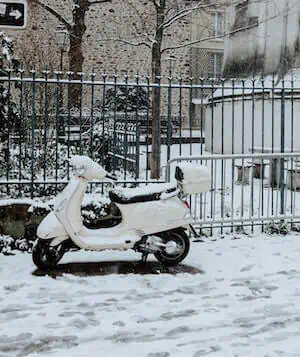When you don’t operate your motorcycle on public roads, you aren’t required to carry an active insurance policy. Does that mean you should cancel your coverage each year to save money?
Some insurers allow motorcyclists to drop or change their coverages or limits while the bike is off the road or kept in storage.
Didn't You Try Our Quote Comparison Tool Yet? Save BIG by Doing it!
If you lease or finance a motorcycle, the lender will likely require full insurance – even if you’re not riding it.
Table of Content
Why Is Full Insurance Required for Financed or Leased Motorcycles?
Lenders and leasing companies in the United States retain motorcycle ownership when riders use these options to acquire a preferred bike. You’re “renting” the vehicle until you pay off the loan.
These entities want to protect their investment in you by requiring full coverage on the motorcycle. If you wreck the bike, they’d have no recourse to recover the loan beyond potentially expensive litigation.
By requiring insurance, they protect their financial interests. Your investment in a complete policy provides the same benefit to each rider.
Why Winter Layup Insurance Makes Sense
When your motorcycle is in storage for the winter, some risks are still present that could cause financial harm.
You’d be responsible for the loss if someone stole your bike without insurance. Without coverage, your only hope would be the recovery of the motorcycle without any damage occurring.
Fires and flooding can happen in storage areas. General liability policies do not cover these issues.
Some insurance companies increase prices based on market conditions each year. There’s no guarantee you’ll receive the same rate if you cancel your coverage for the winter.
If your winters are typically mild, consider asking about layup policies that let you hit the roads without changing your coverage. You can receive one or more usage days with seasonal insurance so that a sunny day doesn’t go to waste.
When you know, you won’t ride the bike until spring, winterize the motorcycle and invest in a layup policy.
How to Winterize Your Motorcycle?
When winter arrives, the roads around your home might become unsafe to travel on a motorcycle. Instead of keeping it available to ride on the occasional beautiful day, it might be cheaper to store the bike for the season and wait until spring.
If you decide to winterize your motorcycle, take these steps to ensure it’ll be ready to ride once the weather warms up.
- Allow your motorcycle to idle for a few minutes if it has been sitting for a day or two. It might help to take a short ride to burn off any water or contaminants in the oil. You’ll also heat the chain, which makes it easier to lubricate for storage.
- Fill your fuel tank instead of draining it completely. Most bikes have fuel injection today, which means you’d have to physically remove the gasoline by pumping it out.
- Adding gas drives out the air and water, and a stabilizer prevents things from getting gummy.
- Once you get the motorcycle to its storage area, take a few minutes to lubricate the chain. If it’s warm, the fluids will get to all the rollers and links consistently, protecting them from corrosion.
- Replace the transmission fluid and engine oil. These items can become foul if they sit for a long time, especially if they aren’t changed during the riding season.
- If you plan to store your motorcycle for more than 30 days, consider fogging the cylinders.
- Give the exterior a good wash and wax to remove potential debris that could harm your bike.
Once the motorcycle is prepped for storage, you’ll want to find a warm spot where it can sit. That could be a garage, a storage unit, or a locked shed. If the bike is outside, you’ll want to ensure a cover is available to protect it.
How Much Does Seasonal Insurance Save Motorcyclists?
The amount you can save with seasonal layup insurance for a motorcycle depends on how long you keep the bike in storage.
If you live in the northern or northeastern states, such as Wisconsin, Michigan, New York, Massachusetts, Maine, New Hampshire, Vermont, and the Dakotas, you might need to store your bike from November to March.
When you live in a more temperate climate, you might only store your motorcycle in December and January.
Winterizing your motorcycle for half the year means it isn’t on the road for that time. A layup policy makes sense because you can protect it against unexpected damage or theft while keeping it ready to ride when the weather cooperates.
If you only stop riding the motorcycle for a couple of months, you’ll have more liability insurance coverage to pay because the bike is usable for a longer time.
Another option is to increase the deductible on your insurance policy if you want to save money. Combining this tactic with seasonal insurance can lower your overall rates by 35% or more. The downside to a higher deductible is that you’ll pay more out-of-pocket if something happens to the motorcycle.
Seasonal layup insurance makes sense for a lot of motorcyclists during the winter. Since each circumstance is different, it helps to shop for the best rates, sunny day clause availability, and other protection options you need for your bike.
Use This Tool for Free and Save on Quotes!






